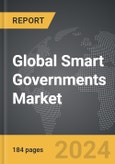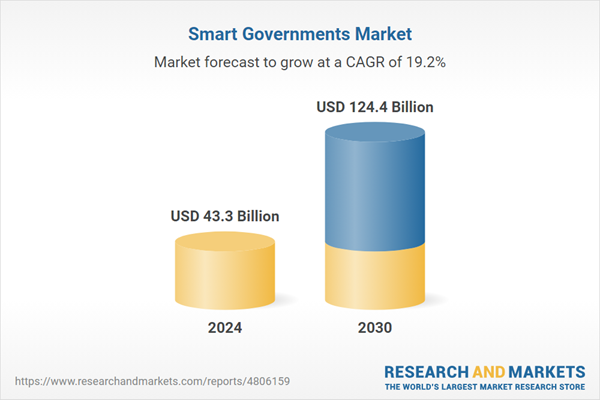The global market for Smart Governments was valued at US$43.3 Billion in 2024 and is projected to reach US$124.4 Billion by 2030, growing at a CAGR of 19.2% from 2024 to 2030. This comprehensive report provides an in-depth analysis of market trends, drivers, and forecasts, helping you make informed business decisions. The report includes the most recent global tariff developments and how they impact the Smart Governments market.
Segments: Component (Solution, Service); Deployment type (On-Premise Deployment, Hosted/Cloud).
Geographic Regions/Countries: World; United States; Canada; Japan; China; Europe (France; Germany; Italy; United Kingdom; and Rest of Europe); Asia-Pacific; Rest of World.
The analysts continuously track trade developments worldwide, drawing insights from leading global economists and over 200 industry and policy institutions, including think tanks, trade organizations, and national economic advisory bodies. This intelligence is integrated into forecasting models to provide timely, data-driven analysis of emerging risks and opportunities.
Global Smart Governments Market - Key Trends and Drivers Summarized
Smart Governments: Embracing Digital Transformation for Efficient Governance
Smart governments are transforming the way public services are delivered by leveraging digital technologies such as Artificial Intelligence (AI), Internet of Things (IoT), blockchain, and data analytics. These technologies enable governments to offer citizen-centric services that are more efficient, transparent, and accessible. The implementation of e-governance platforms allows for seamless communication between government bodies and citizens, reducing administrative overheads and increasing service delivery speed. From smart traffic management systems to digital tax filing services, smart governments are adopting innovative solutions to tackle urban challenges and improve the quality of life for their citizens. As more countries prioritize smart governance to enhance public welfare, the smart government market continues to grow, driven by increasing investments in smart city projects and digital infrastructure.What Role Do Emerging Technologies Play in Shaping Smart Governments?
Emerging technologies like AI, blockchain, and Big Data are at the core of smart government initiatives, offering enhanced capabilities for data-driven decision-making, security, and efficiency. AI is being used to analyze vast amounts of data for predictive analysis and policy formulation, while blockchain is providing secure and transparent transaction frameworks for public services like land registries, voting, and identity management. Big Data analytics enables governments to harness real-time data to understand citizen needs better and optimize resource allocation. Additionally, IoT-based sensors are widely employed in smart cities to manage public utilities, monitor pollution levels, and enhance emergency response systems. These technologies are not only enhancing the effectiveness of governance but also promoting sustainability and economic development.Which Segments Are Dominating the Smart Government Market?
Components include hardware, software, and services, with software solutions dominating the market due to the high demand for cloud-based e-governance platforms and AI-driven analytics tools. Solution types range from smart infrastructure and public safety to digital government services and citizen engagement platforms, with public safety solutions witnessing the highest adoption due to growing concerns over urban security and safety. The market is further segmented by deployment modes, including on-premise and cloud-based solutions, with cloud deployment gaining traction for its scalability and cost-effectiveness. Regionally, North America and Europe lead the market due to advanced digital infrastructure and supportive government policies, while Asia-Pacific is rapidly emerging due to increasing smart city initiatives and rising investments in digital transformation.What Factors Are Driving the Growth in the Smart Government Market?
The growth in the smart government market is driven by several factors, including the increasing need for digital transformation in public services, rising investments in smart city projects, and the growing adoption of AI, blockchain, and IoT technologies in governance. The demand for efficient and transparent public service delivery, the need for enhanced security and data privacy, and government initiatives promoting e-governance are also contributing to market expansion. Additionally, the emergence of 5G connectivity, the development of citizen engagement platforms, and the increasing use of data analytics for policy-making and resource management are driving growth. Strategic partnerships between technology providers and government bodies and the expansion of public-private partnerships (PPPs) are further accelerating the adoption of smart government solutions.Report Scope
The report analyzes the Smart Governments market, presented in terms of units. The analysis covers the key segments and geographic regions outlined below.Segments: Component (Solution, Service); Deployment type (On-Premise Deployment, Hosted/Cloud).
Geographic Regions/Countries: World; United States; Canada; Japan; China; Europe (France; Germany; Italy; United Kingdom; and Rest of Europe); Asia-Pacific; Rest of World.
Key Insights:
- Market Growth: Understand the significant growth trajectory of the Solution segment, which is expected to reach US$81.3 Billion by 2030 with a CAGR of a 17.7%. The Service segment is also set to grow at 22.5% CAGR over the analysis period.
- Regional Analysis: Gain insights into the U.S. market, valued at $11.7 Billion in 2024, and China, forecasted to grow at an impressive 17.9% CAGR to reach $18.5 Billion by 2030. Discover growth trends in other key regions, including Japan, Canada, Germany, and the Asia-Pacific.
Why You Should Buy This Report:
- Detailed Market Analysis: Access a thorough analysis of the Global Smart Governments Market, covering all major geographic regions and market segments.
- Competitive Insights: Get an overview of the competitive landscape, including the market presence of major players across different geographies.
- Future Trends and Drivers: Understand the key trends and drivers shaping the future of the Global Smart Governments Market.
- Actionable Insights: Benefit from actionable insights that can help you identify new revenue opportunities and make strategic business decisions.
Key Questions Answered:
- How is the Global Smart Governments Market expected to evolve by 2030?
- What are the main drivers and restraints affecting the market?
- Which market segments will grow the most over the forecast period?
- How will market shares for different regions and segments change by 2030?
- Who are the leading players in the market, and what are their prospects?
Report Features:
- Comprehensive Market Data: Independent analysis of annual sales and market forecasts in US$ Million from 2024 to 2030.
- In-Depth Regional Analysis: Detailed insights into key markets, including the U.S., China, Japan, Canada, Europe, Asia-Pacific, Latin America, Middle East, and Africa.
- Company Profiles: Coverage of players such as ABB Group, Amazon Web Services, Inc., Avaya, Inc., Cap Gemini SA, Cisco Systems, Inc. and more.
- Complimentary Updates: Receive free report updates for one year to keep you informed of the latest market developments.
Some of the 22 companies featured in this Smart Governments market report include:
- ABB Group
- Amazon Web Services, Inc.
- Avaya, Inc.
- Cap Gemini SA
- Cisco Systems, Inc.
- Entrust Datacard Corporation
- Huawei Technologies Co., Ltd.
- Hughes Identification Devices (Hid) Global Corp.
- IBM Corporation
- Imex Systems Inc.
- Nokia Corporation
- Opengov
- Oracle Corporation
- Socrata, Inc.
- Symantec Corporation
- Uti Grup (Romania)
Tariff Impact Analysis: Key Insights for 2025
Global tariff negotiations across 180+ countries are reshaping supply chains, costs, and competitiveness. This report reflects the latest developments as of April 2025 and incorporates forward-looking insights into the market outlook.The analysts continuously track trade developments worldwide, drawing insights from leading global economists and over 200 industry and policy institutions, including think tanks, trade organizations, and national economic advisory bodies. This intelligence is integrated into forecasting models to provide timely, data-driven analysis of emerging risks and opportunities.
What’s Included in This Edition:
- Tariff-adjusted market forecasts by region and segment
- Analysis of cost and supply chain implications by sourcing and trade exposure
- Strategic insights into geographic shifts
Buyers receive a free July 2025 update with:
- Finalized tariff impacts and new trade agreement effects
- Updated projections reflecting global sourcing and cost shifts
- Expanded country-specific coverage across the industry
Table of Contents
I. METHODOLOGYII. EXECUTIVE SUMMARY2. FOCUS ON SELECT PLAYERSIII. MARKET ANALYSISIV. COMPETITION
1. MARKET OVERVIEW
3. MARKET TRENDS & DRIVERS
4. GLOBAL MARKET PERSPECTIVE
UNITED STATES
CANADA
JAPAN
CHINA
EUROPE
FRANCE
GERMANY
ITALY
UNITED KINGDOM
REST OF EUROPE
ASIA-PACIFIC
REST OF WORLD
Companies Mentioned (Partial List)
A selection of companies mentioned in this report includes, but is not limited to:
- ABB Group
- Amazon Web Services, Inc.
- Avaya, Inc.
- Cap Gemini SA
- Cisco Systems, Inc.
- Entrust Datacard Corporation
- Huawei Technologies Co., Ltd.
- Hughes Identification Devices (Hid) Global Corp.
- IBM Corporation
- Imex Systems Inc.
- Nokia Corporation
- Opengov
- Oracle Corporation
- Socrata, Inc.
- Symantec Corporation
- Uti Grup (Romania)
Table Information
| Report Attribute | Details |
|---|---|
| No. of Pages | 184 |
| Published | April 2025 |
| Forecast Period | 2024 - 2030 |
| Estimated Market Value ( USD | $ 43.3 Billion |
| Forecasted Market Value ( USD | $ 124.4 Billion |
| Compound Annual Growth Rate | 19.2% |
| Regions Covered | Global |









